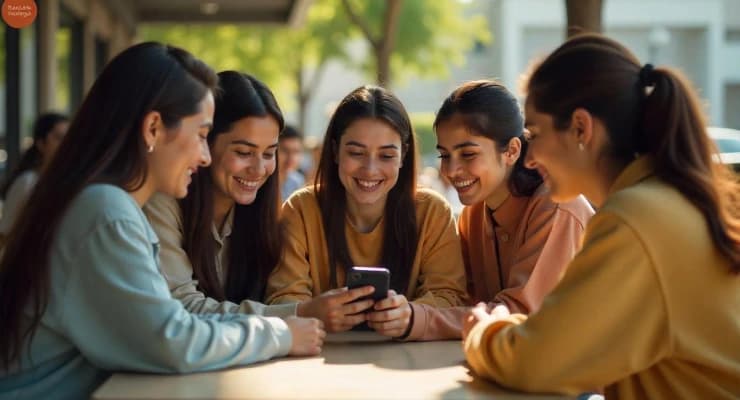© 2025 Roz UpdatesbyTETRA SEVEN

* All product/brand names, logos, and trademarks are property of their respective owners.
In recent years, a significant shift has emerged in how young people in Pakistan consume news and stay informed. For Generation Z — those born between the mid-1990s and early 2010s — the screen in their pocket is far more than just a device for entertainment. It’s their primary window to the world. Traditional news channels, once the cornerstone of daily information for older generations, are steadily losing traction with this digitally native cohort. In their place, platforms like TikTok have risen to prominence, not just for dance videos and viral challenges, but increasingly as a source of news and socio-political awareness.
In Pakistan, this generational media evolution is striking. Gen Z is mobile-first, visually driven, and seeks content that is fast, digestible, and, most importantly, authentic. TikTok, with its short-form videos and hyper-personalized algorithm, delivers exactly that. Whether it’s a political commentary by a local influencer, a real-time update on a protest, or an explainer video breaking down a complex issue in under 60 seconds — TikTok is becoming the go-to platform for information.
Meanwhile, traditional news channels struggle to keep up. Long broadcasts, perceived bias, outdated presentation styles, and lack of interactivity have alienated younger audiences. Many Gen Z viewers find these outlets unrelatable and inaccessible, often tuned to the preferences of an older demographic.
This blog will dive deep into why Gen Z in Pakistan prefers TikTok over traditional news channels, examining the technological, cultural, and behavioral factors behind this media shift. We’ll explore how TikTok’s format aligns with Gen Z’s preferences, what this means for the future of journalism, and why it’s critical for legacy media to adapt or risk becoming obsolete.
Generation Z in Pakistan, much like their global counterparts, has reshaped how media is consumed, shared, and even created. One of the most significant drivers of their preference for TikTok over traditional news channels lies in how seamlessly the platform fits their lifestyles, values, and attention spans. Unlike older generations, Gen Z doesn’t wait for the 9 PM news bulletin — they want updates in real-time, in a format that matches their mobile-first, on-the-go consumption patterns.
TikTok’s short-form video format is perfectly aligned with Gen Z’s desire for rapid information consumption. With average attention spans shrinking, young audiences are drawn to videos that get to the point quickly and keep them entertained while informing. Whether it’s a 30-second summary of a political event, a humorous take on a social issue, or a viral challenge related to current affairs, the platform’s visual-first nature makes it more digestible than scrolling through lengthy articles or tuning in to hour-long news programs.
This format particularly resonates in Pakistan, where high data costs and patchy internet infrastructure make lightweight, quick-to-load videos more accessible than high-resolution live TV streams or large news websites.
Another major draw is TikTok’s incredibly refined algorithm. It learns what users like, what they skip, and what they rewatch — curating a “For You Page” that delivers highly relevant and engaging content. For Gen Z, who value personalization and autonomy, this means their news feed is tailor-made, unlike the rigid programming of traditional news channels.
In Pakistan, this algorithmic curation means a young user in Lahore might be fed content about local protests, educational reforms, or celebrity commentary — all wrapped in formats that speak their language and reflect their realities.
Unlike traditional media, which often broadcasts in one direction, TikTok enables two-way interaction. Gen Z users don’t just consume content; they remix it, comment on it, and share their takes. This participatory nature of TikTok turns news into a conversation, not a monologue.
From stitching videos to responding with duets, Pakistani Gen Z is engaging with news in dynamic, creative ways — turning a passive act into a deeply social experience.
While TikTok is rising in influence among Gen Z in Pakistan, the flip side of this trend is the steady decline of traditional news channels. This isn’t simply a matter of technology — it’s a deeper shift in trust, relevance, and accessibility. Gen Z is not only bypassing legacy news platforms but also questioning their very credibility and purpose in today’s fast-paced digital ecosystem.
Gen Z places a high value on authenticity. Heavily produced news broadcasts, anchored by personalities who often feel distant or scripted, don’t resonate with their expectations. Traditional news outlets in Pakistan often prioritize political debates or government-led narratives, which feel disconnected from the daily struggles and concerns of the average young Pakistani.
In contrast, TikTok’s grassroots creators use informal language, relatable formats, and humor — making complex issues feel more understandable and engaging. This creates a sense of realism and connection that traditional outlets often fail to deliver.
Traditional media follows a top-down model: producers create content and audiences passively consume it. For a generation that grew up engaging with content — liking, sharing, commenting, or even remixing — this model feels outdated. Gen Z doesn’t want to be lectured to; they want to participate in the conversation.
TikTok allows that. Through likes, shares, duets, and comments, users feel involved in the dialogue, which builds a sense of community around news and issues. In Pakistan, where youth activism and civic participation are on the rise, this interactive model is a major draw.
Many traditional Pakistani news channels are not optimized for mobile. Their content is long-form, designed for television, and not repurposed well for digital platforms. Meanwhile, Gen Z expects mobile-first, quick-loading, and visually compelling content.
Moreover, the tone of mainstream media often feels patronizing or overly serious to younger audiences. This generational disconnect — where youth feel misunderstood or ignored — further drives them toward platforms like TikTok, where their voices are not only heard but amplified.
TikTok has evolved beyond being a platform for viral dances and lip-sync videos — it has emerged as a powerful tool for shaping how news is consumed and interpreted, especially among Gen Z in Pakistan. As traditional gatekeepers of news lose their grip, TikTok is empowering everyday users to become informers, commentators, and storytellers. This democratization of information is transforming how younger audiences engage with the world around them.
One of TikTok’s most defining features is its ability to give anyone a voice. In Pakistan, influencers and content creators are increasingly stepping into the role of micro-journalists. From covering social issues in rural areas to exposing political controversies or shedding light on cultural taboos, these creators provide perspectives that are often overlooked by mainstream news.
For example, young TikTokers have used the platform to report on flooding, share firsthand experiences of student protests, or break down new legislation in simple Urdu or regional languages. This localized, peer-to-peer approach has made the platform an important news source, especially in underreported communities.
TikTok offers space for alternative stories — ones that don’t often make the headlines on traditional news. Whether it’s highlighting minority voices, celebrating grassroots movements, or discussing mental health and education reform, Gen Z is finding narratives that reflect their identities and realities.
In Pakistan, this means breaking free from politically charged or commercially driven news agendas. TikTok videos allow users to spotlight topics like gender equality, youth employment, and environmental issues — often with more honesty and impact than polished newsroom segments.
However, the platform isn’t without flaws. With its decentralized model, TikTok is vulnerable to misinformation and unverified content spreading rapidly. In the absence of traditional editorial standards, young users may encounter skewed perspectives, false claims, or emotionally manipulative content disguised as fact.
This underscores the need for greater media literacy among Gen Z, so they can critically evaluate the content they consume and distinguish between opinion, fact, and propaganda.
The way Generation Z in Pakistan consumes news is undergoing a radical transformation. With smartphones in hand and a preference for speed, authenticity, and engagement, Gen Z is bypassing traditional news channels in favor of platforms like TikTok. This shift isn’t just about convenience — it reflects deeper values and behaviors: a desire for relatability, two-way communication, and personalized content.
TikTok’s rise as a news platform illustrates how fluid the definition of journalism has become. Influencers, micro-journalists, and even everyday users now hold the power to shape public discourse. For Gen Z, this is empowering. They don’t just want to watch the news — they want to interact with it, critique it, and be a part of the narrative.
In contrast, traditional news outlets in Pakistan face an urgent need to adapt. Their rigid formats, perceived bias, and lack of interactivity are alienating the very audience that will define the future of media. To remain relevant, they must embrace digital-first strategies, experiment with short-form storytelling, and foster greater trust through transparency and inclusivity.
As educators, policymakers, and media professionals reflect on these changes, one thing is clear: the future of news in Pakistan will be shaped by the habits and voices of Gen Z. Embracing this change isn’t optional — it’s essential.

22 November 2025

18 November 2025
No comments yet. Be the first to comment!